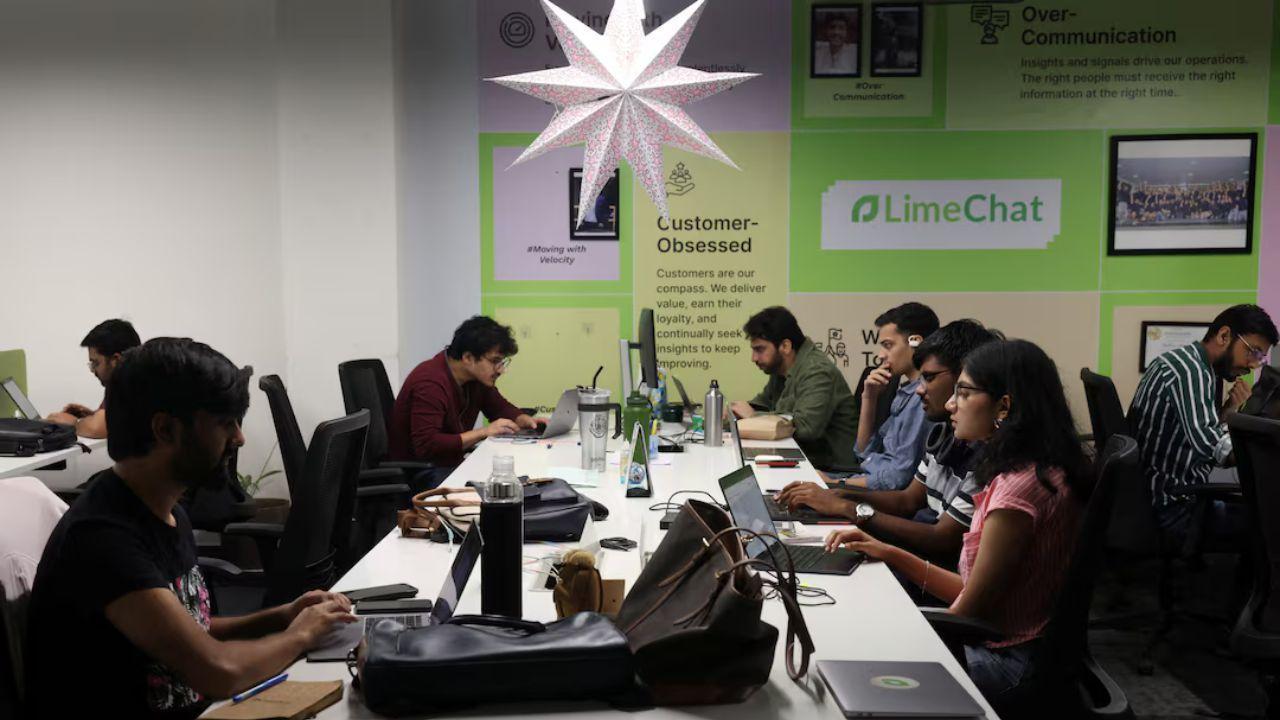
Post by : Saif Nasser
In the busy technology city of Bengaluru, a quiet revolution is happening inside modern startup offices. Here, young developers are building AI chatbots that talk, type, and even think like humans. These smart virtual assistants are slowly taking over the jobs of real people who once worked in India’s call centers and customer support teams.
One of the companies leading this change is LimeChat, a growing AI startup that helps businesses talk to their customers through intelligent chatbots. Its co-founder, Nikhil Gupta, just 28 years old, says their AI system can reduce the number of customer service workers by up to 80%. “Once you hire a LimeChat agent, you never have to hire again,” Gupta said.
For many years, India was called the “back office of the world” because millions of young Indians worked in call centers, providing support to companies in the U.S., Europe, and Asia. But now, technology is moving so fast that computers are starting to do the same work — faster and cheaper.
India’s Big Bet on AI
India’s information technology (IT) industry is worth around $283 billion and provides millions of jobs. Despite fears about automation, the government believes that AI will create new types of work, not destroy it. Prime Minister Narendra Modi said earlier this year, “Work does not disappear due to technology. Its nature changes and new jobs are created.”
Still, many experts are not so sure. Santosh Mehrotra, a former government adviser, said the country has no clear plan for how to protect workers who lose jobs to machines. “There’s no game plan,” he warned.
Today, India’s business process management sector — which includes call centers, data entry, and payroll services — employs about 1.65 million people. But new hiring has dropped sharply because of automation. Two years ago, over 130,000 people were hired in this sector. Last year, that number fell to less than 17,000.
Real People, Real Job Losses
The change is already affecting people’s lives.
Megha S., 32, worked for a software company in Bengaluru and earned around $10,000 a year. She said she lost her job just before the festival season because her company replaced human quality checkers with AI tools. “I was told I am the first one who has been replaced by AI,” she said softly. “I haven’t told my parents yet.”
Her story is not unique. Across India, thousands of workers in customer care roles are being replaced by chatbots that can handle complaints, track orders, and even comfort angry customers.
Some government officials say India should build stronger social security systems, like unemployment benefits, to support workers during this transition. But other officials believe that, in the long run, AI will not hurt overall employment numbers.
The Global Race for Automation
This change in India is part of a bigger global trend. The conversational AI market is growing by 24% each year and could reach $41 billion by 2030, according to Grand View Research.
But there are risks too.
New U.S. tariffs and visa fees could hurt India’s tech exports. Jefferies, a global investment bank, has warned that AI could cause a 50% fall in call-center revenue and a 35% drop in other back-office services over the next five years.
The person who started India’s first call center in the 1990s, Pramod Bhasin, believes that while many jobs will vanish, India can still benefit by becoming the “AI factory of the world.” That means training young people to design, build, and manage AI systems instead of doing routine support tasks.
LimeChat’s Growing Power
Inside LimeChat’s office in Bengaluru, rows of engineers work on code that can automate conversations for e-commerce, banking, and healthcare companies. Gupta says his company’s chatbots have already replaced about 5,000 human jobs across India.
For 100,000 rupees (around $1,130) a month, a company can use LimeChat’s bot to handle the same workload as 15 customer service employees. The company’s revenue has exploded — from just $79,000 in 2022 to $1.5 million in 2024.
LimeChat’s system works through WhatsApp and other messaging apps. One of its clients, Kapiva, an Indian ayurvedic brand, uses it to answer questions about diets and herbal products. When a customer asks, “What kind of diet should I follow to lose weight?” the chatbot instantly creates a meal plan and recommends Kapiva products, even using friendly emojis.
Another big company, Mamaearth, uses LimeChat bots to manage thousands of daily queries from online shoppers. “Providing good customer support is make or break for us,” said Vipul Maheshwari, head of analytics at Mamaearth’s parent company, Honasa Consumer. “But we can’t keep expanding our human support team forever.”
The Rise of Haptik and The Media Ant
LimeChat is not alone. Reliance Industries, owned by billionaire Mukesh Ambani, bought another AI firm called Haptik in 2019. Haptik says its “AI agents” can cut customer service costs by 30%, offering round-the-clock help for as little as 10,000 rupees per month.
Similarly, The Media Ant, a Bengaluru advertising firm, has replaced 40% of its workers with AI tools. Its founder, Samir Chaudhary, said the company now uses a digital assistant named Neha. Neha speaks perfect Indian-accented English, finds new clients, and even sends follow-up emails. When asked about YouTube ads, she politely collects information and ends with, “Have a great day!”
“Ask her out for coffee and she will laugh it off,” Chaudhary joked.
But Not Everyone Is Convinced
Despite these advances, AI systems still have limits. In one test, a LimeChat bot could not answer a question about the proof behind a medical brand’s claims. “I’m sorry, I don’t have enough information,” it replied.
A 2024 EY survey found that 62% of Indian consumers make purchases influenced by AI recommendations, but 78% still prefer speaking to a real person when they need help. This shows that many people still value the human touch, even in a digital world.
Even big global companies like Klarna in Sweden have learned hard lessons. After cutting thousands of jobs using AI, Klarna’s CEO admitted that the company is now “trying to course correct” — focusing on using AI to improve products rather than just reduce costs.
The Future of India’s Workforce
The rise of AI chatbots in India is both exciting and worrying. On one hand, it shows the country’s growing power in technology and innovation. On the other hand, it exposes the fears of millions of workers whose jobs depend on routine tasks that AI can easily perform.
India’s challenge now is to make sure that the new jobs created by AI are enough to replace the ones it destroys. Experts say the country needs to invest heavily in retraining programs so that call center workers can become AI coordinators, data analysts, or engineers.
As Nikhil Gupta of LimeChat puts it, “You need only a small number of people to handle negative experiences. Everything else, AI can do better.”
The question that remains is whether India’s workers will be able to adapt fast enough — before the chatbots completely take their place.










OpenAI Highlights Growing Cybersecurity Threats from Emerging AI Technologies
OpenAI has raised alarms about the increasing cyber risks from its upcoming AI models, emphasizing s

Manchester City Triumphs 2-1 Against Real Madrid, Alonso Faces Increased Scrutiny
Manchester City secured a 2-1 victory over Real Madrid, raising concerns for coach Xabi Alonso amid

Cristiano Ronaldo Leads Al Nassr to 4-2 Victory Over Al Wahda in Friendly Face-Off
Ronaldo's goal helped Al Nassr secure a 4-2 friendly win over Al Wahda, boosting anticipation for th

Landon Donovan Challenges Australia Coach on World Cup Prospects
Landon Donovan counters Australia coach Tony Popovic’s optimism for the World Cup, expecting an earl

Mercedes-Benz Forms Landmark Partnership with WTA
Mercedes-Benz and the WTA unveil a significant partnership effective January 2026, with major invest

Abhishek Addresses Divorce Rumours Concerning His Family
Abhishek Bachchan confirms that daughter Aaradhya remains oblivious to divorce speculations, focusin